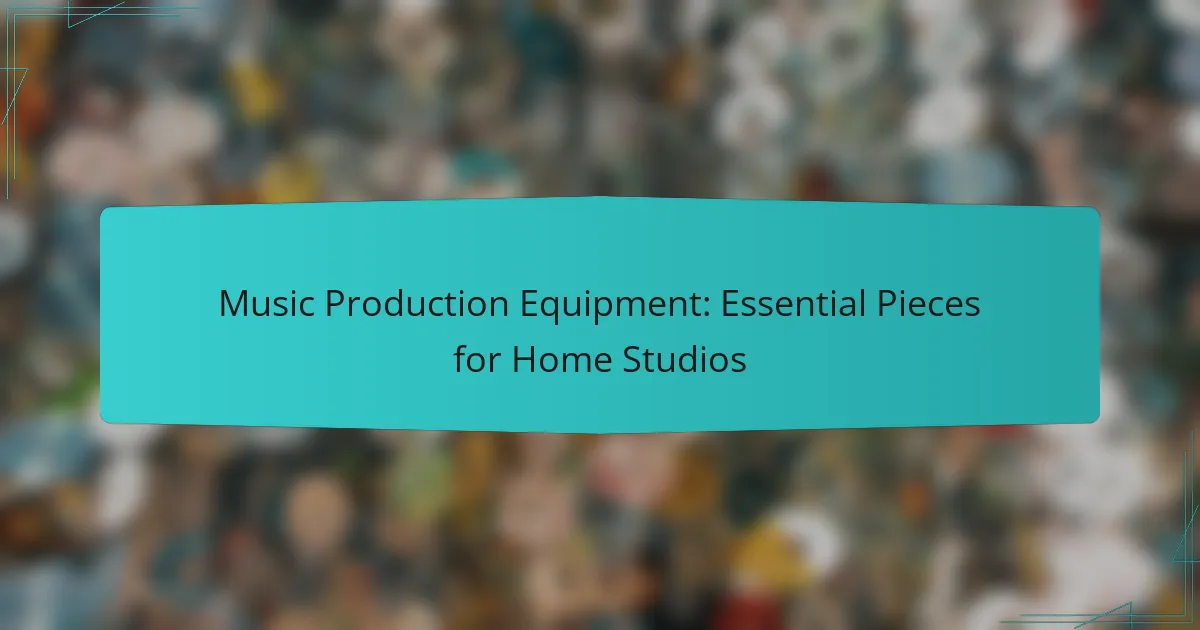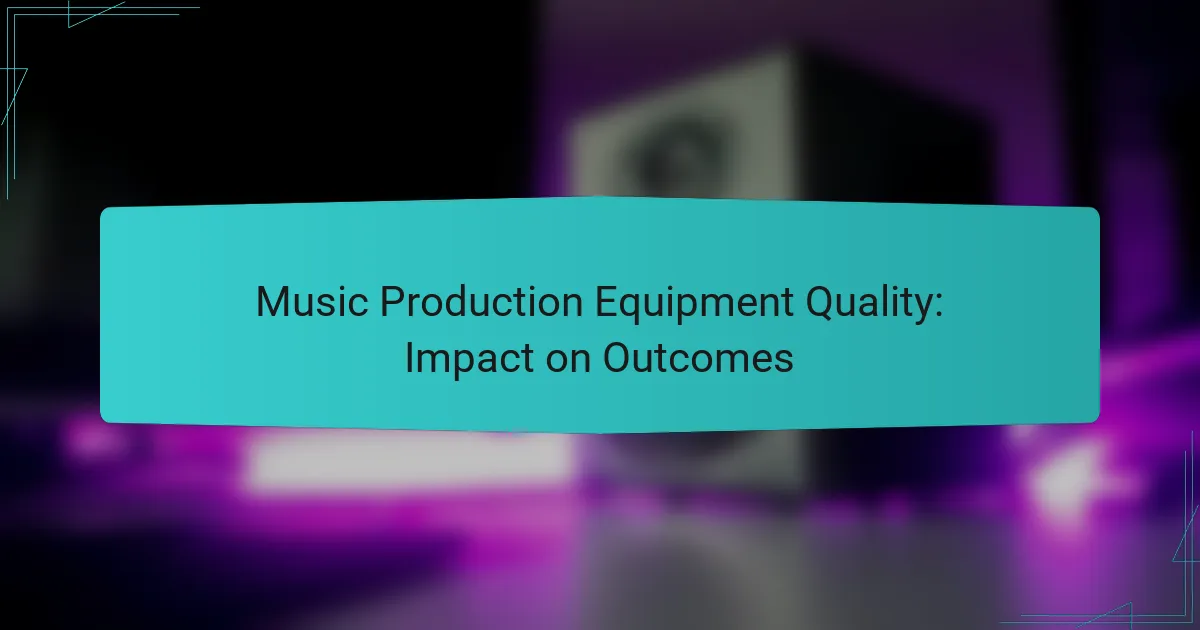When it comes to music production, selecting the right microphone is crucial for capturing sound with clarity and precision. Your choice will depend on various factors, including the type of sound you wish to record, the recording environment, and your budget. Understanding the differences between dynamic and condenser microphones, as well as key features like polar patterns and frequency response, will help you make an informed decision tailored to your specific needs.
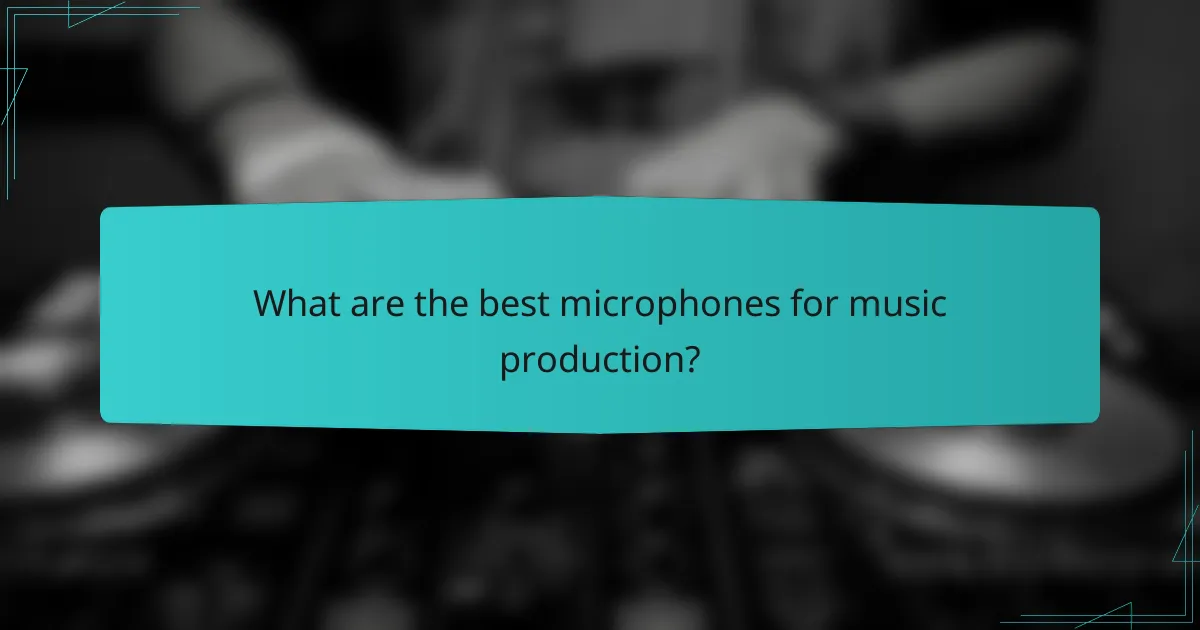
What are the best microphones for music production?
The best microphones for music production vary based on your specific recording needs, such as voice, instruments, or studio environment. Popular choices include dynamic and condenser microphones, each offering unique characteristics that suit different applications.
Shure SM7B dynamic microphone
The Shure SM7B is a versatile dynamic microphone known for its warm sound and excellent rejection of background noise. It’s particularly favored for vocal recordings, especially in live settings or untreated rooms.
This microphone features a cardioid pickup pattern, which helps isolate the sound source while minimizing ambient noise. Its robust design and ability to handle high sound pressure levels make it ideal for various instruments as well.
Audio-Technica AT2020 condenser microphone
The Audio-Technica AT2020 is a popular entry-level condenser microphone that delivers a clear and detailed sound. It’s suitable for vocals and acoustic instruments, making it a great choice for home studios.
With a cardioid pattern, the AT2020 effectively captures sound from the front while reducing noise from the sides and rear. Its affordability and quality make it a go-to option for beginners and experienced producers alike.
Rode NT1-A large diaphragm condenser
The Rode NT1-A is renowned for its low self-noise and wide frequency response, making it an excellent choice for studio recordings. This large diaphragm condenser microphone excels at capturing vocals and acoustic instruments with remarkable clarity.
Its cardioid pattern helps to focus on the sound source while rejecting unwanted noise. The NT1-A is often praised for its warm sound and is frequently used in professional studios for vocal tracks.
Neumann U87 studio microphone
The Neumann U87 is a legendary studio microphone known for its exceptional sound quality and versatility. It’s widely used in professional settings for vocals, instruments, and voiceovers.
This microphone offers selectable polar patterns (cardioid, omnidirectional, and figure-8), allowing for flexibility in different recording environments. Its high price reflects its status as a top-tier choice for serious music producers.
AKG C414 XLS multi-pattern microphone
The AKG C414 XLS is a highly versatile multi-pattern condenser microphone that excels in various recording situations. It features nine selectable polar patterns, making it adaptable for vocals, instruments, and even ambient recording.
With its detailed sound reproduction and low self-noise, the C414 XLS is ideal for capturing nuanced performances. Its flexibility and high-quality output make it a staple in many professional studios around the world.

How to choose a microphone for music production?
Choosing a microphone for music production involves understanding your specific needs, including the type of sound you want to capture and the environment in which you’ll be recording. Key factors include microphone type, frequency response, sensitivity, budget, and brand reputation.
Consider microphone type: dynamic vs. condenser
The choice between dynamic and condenser microphones significantly impacts your recording quality. Dynamic microphones are robust and ideal for loud sound sources, such as drums or guitar amplifiers, while condenser microphones are more sensitive and suited for capturing vocals and acoustic instruments.
For studio settings, condenser mics are often preferred due to their wider frequency response and ability to capture subtle nuances. However, if you’re recording live performances or in untreated spaces, dynamic mics can be more forgiving and durable.
Evaluate frequency response and sensitivity
Frequency response refers to the range of frequencies a microphone can capture effectively. A microphone with a flat frequency response is versatile, while one with tailored response may enhance specific sound characteristics, such as warmth in vocals.
Sensitivity indicates how well a microphone converts sound waves into electrical signals. Higher sensitivity mics are better for quiet sources, but they may also pick up unwanted background noise. Aim for a balance based on your recording environment and intended use.
Assess budget and brand reputation
Your budget will play a crucial role in selecting a microphone. Quality microphones can range from low tens to several hundred USD, so it’s essential to determine what features are most important to you without overspending.
Brand reputation can guide your decision, as established brands often have a history of reliability and performance. Research user reviews and professional recommendations to ensure you choose a microphone that meets your needs and expectations.
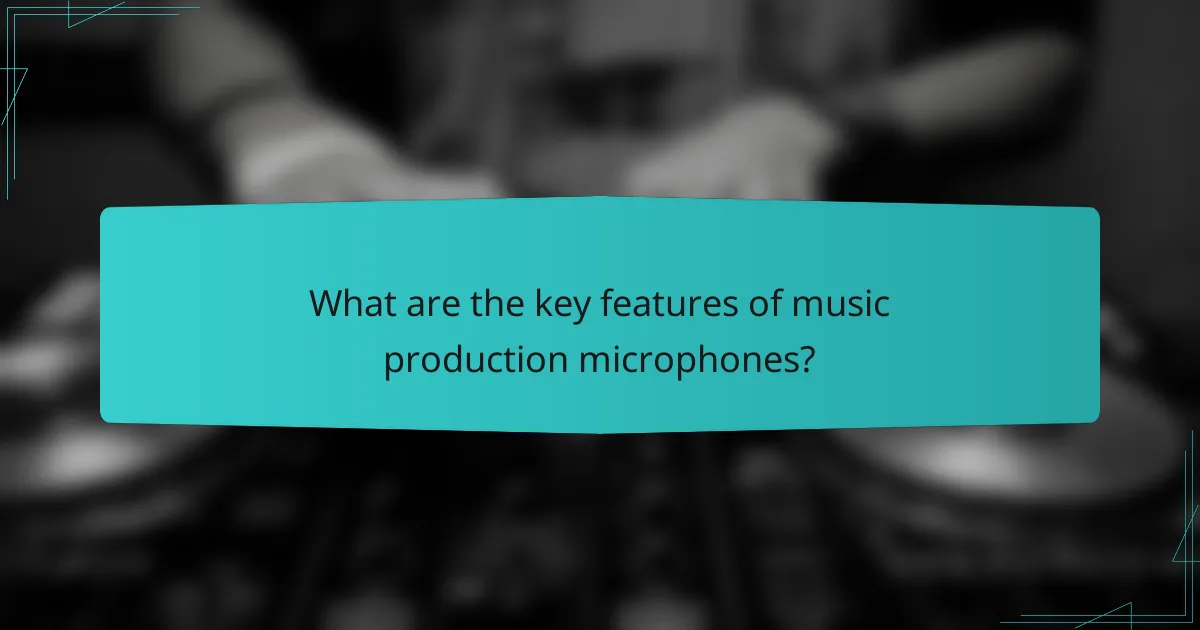
What are the key features of music production microphones?
Music production microphones are essential tools that capture sound with clarity and precision. Key features to consider include polar patterns, frequency response range, and maximum sound pressure level (SPL) handling, all of which influence how a microphone performs in different recording scenarios.
Polar patterns: cardioid, omnidirectional, bidirectional
Polar patterns define how microphones pick up sound from various directions. Cardioid microphones are most sensitive to sound coming from the front, making them ideal for vocals and instruments in noisy environments. Omnidirectional mics capture sound equally from all directions, which is useful for recording ambient sounds or group performances.
Bidirectional microphones pick up sound from the front and back while rejecting sound from the sides. This pattern is often used for duet recordings or interviews, allowing two sound sources to be captured simultaneously while minimizing background noise.
Frequency response range
The frequency response range indicates the spectrum of sound frequencies a microphone can capture, typically measured in Hertz (Hz). Most studio microphones cover a range from around 20 Hz to 20 kHz, which encompasses the full range of human hearing. A wider frequency response can enhance the microphone’s ability to capture subtle nuances in sound.
When selecting a microphone, consider what you will be recording. For instance, a mic with a boosted high-frequency response may be beneficial for vocals, while one with a flatter response might be better for instruments to ensure a more natural sound.
Maximum SPL handling
Maximum SPL handling refers to the highest sound pressure level a microphone can tolerate before distortion occurs. This is crucial for recording loud sound sources, such as drums or amplifiers. Microphones with a maximum SPL rating of around 130 dB to 150 dB are common for studio use, allowing them to handle a variety of instruments without compromising sound quality.
When choosing a microphone, ensure its SPL handling capacity matches your recording needs. If you frequently work with loud sources, opt for a mic with a higher SPL rating to avoid distortion and maintain audio clarity.

What is the importance of microphone placement in music production?
Microphone placement is crucial in music production as it directly affects the sound quality and overall recording. Proper positioning can enhance clarity, balance, and the desired tonal characteristics of the audio being captured.
Impact on sound quality
The placement of a microphone can significantly influence the sound quality of a recording. For instance, positioning a microphone too close to a sound source may result in excessive bass, while placing it too far can lead to a thin or distant sound. A common practice is to start with the microphone about six to twelve inches away from the source and adjust based on the desired effect.
Additionally, the angle and direction of the microphone can alter the tonal balance. Experimenting with different placements can help achieve a richer and more defined sound, especially in multi-instrument recordings where clarity is essential.
Influence on recording environment
The recording environment plays a significant role in how microphone placement affects sound. Factors such as room acoustics, background noise, and reflective surfaces can alter the captured audio. For example, placing a microphone in a corner may enhance low frequencies due to reflections, while positioning it in an open space can yield a more natural sound.
To optimize recording conditions, consider using acoustic treatment like foam panels or bass traps to minimize unwanted reflections. Always assess the environment before finalizing microphone placement to ensure the best possible recording quality.
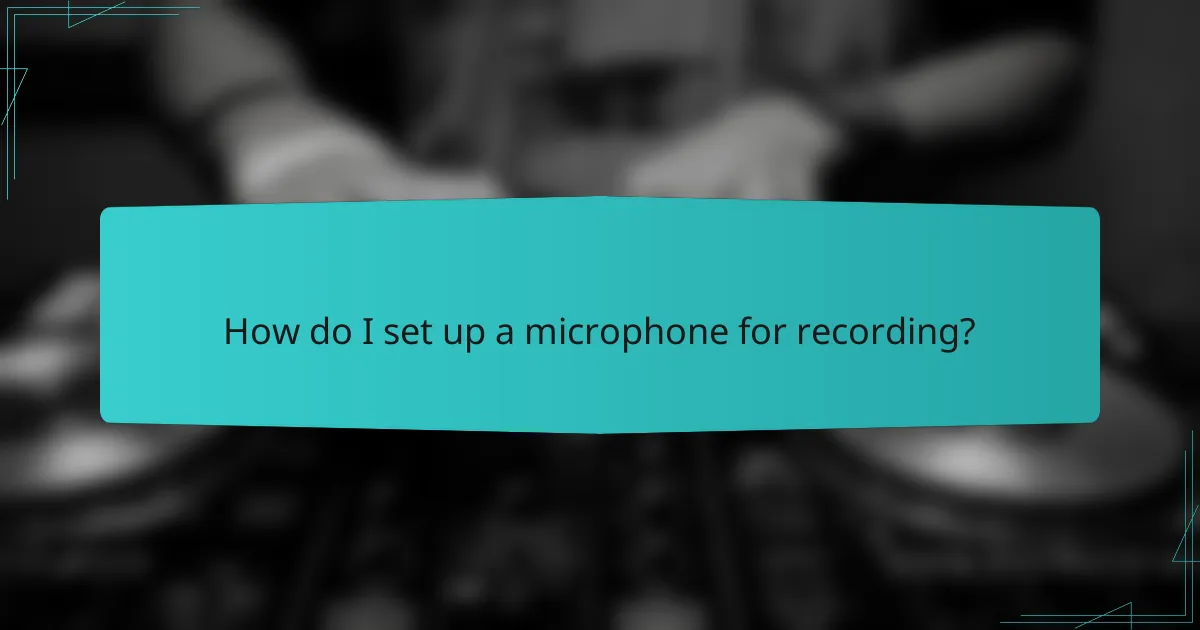
How do I set up a microphone for recording?
Setting up a microphone for recording involves connecting it to an audio interface, adjusting gain levels, and monitoring sound quality. Proper setup ensures clear audio capture and minimizes issues during recording sessions.
Choose the right audio interface
Selecting an appropriate audio interface is crucial for effective microphone setup. Look for interfaces that match your microphone type, whether it’s USB for convenience or XLR for professional quality. Consider the number of inputs and outputs you need based on your recording setup.
Popular options include Focusrite Scarlett series and PreSonus AudioBox, which are known for their reliability and sound quality. Ensure the interface is compatible with your recording software to avoid technical issues.
Connect microphone and adjust gain levels
After choosing an audio interface, connect your microphone using the appropriate cable. For XLR microphones, use a balanced cable to reduce noise. Once connected, adjust the gain levels on the interface to ensure the microphone captures sound without distortion.
A good rule of thumb is to set the gain so that the loudest sounds peak around -12 to -6 dB on your audio interface. This provides headroom for unexpected volume spikes while maintaining clarity.
Test and monitor sound levels
Before starting your recording, conduct a sound check to monitor levels. Speak or play your instrument at the intended volume and observe the interface’s meters. Adjust the gain if necessary to avoid clipping or too low a signal.
Utilize headphones to listen for any unwanted background noise or issues. This allows you to make adjustments in real-time, ensuring the best possible recording quality. Regularly check levels throughout your session to maintain optimal sound.


